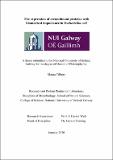| dc.contributor.advisor | Wall, Gerard | |
| dc.contributor.author | Tilbury, Maura A. | |
| dc.date.accessioned | 2020-07-27T11:58:25Z | |
| dc.date.available | 2020-07-27T11:58:25Z | |
| dc.date.issued | 2020-01-30 | |
| dc.identifier.uri | http://hdl.handle.net/10379/16104 | |
| dc.description.abstract | Naturally-occurring peptides and proteins with diverse biological roles have enormous
potential for use as therapeutics and biomaterials. While proteins of biomedical interest were
traditionally isolated from their native sources, advances in recombinant protein expression
have now enabled safe, efficient and large-scale production of highly pure protein. This project
utilised Escherichia coli as an expression host for two recombinant proteins with potential
biomedical application: (i) a barnacle cement protein for investigation as a biomimetic glue,
and (ii) human superoxide dismutase enzyme for targeted pulmonary delivery.
Proteins involved in wet adhesion of marine organisms are of growing biomedical interest due
to their potential use as surgical adhesives. Recombinant protein technology allows such
adhesive proteins to be produced at the scale needed to investigate their adhesive mechanisms.
The 19 kDa cement protein (cp19k) of the stalked barnacle Pollicipes pollicipes was expressed
in E. coli BL21. Co-overproduction of E. coli molecular chaperones GroEL-GroES and trigger
factor (TF) resulted in increased yields of soluble cp19k protein. Surface coat analysis revealed
high adsorption of a cp19k-TF complex on both hydrophobic and hydrophilic surfaces but low
adsorption of the recombinant cp19k (rPpolcp19k) protein. The purified recombinant protein
also exhibited negligible adsorption on hydrophobic, neutral hydrophilic or charged self-assembled
monolayers in surface plasmon resonance assays designed to mimic the barnacle
cement gland and seawater conditions. Due to its low adhesive capability, the potential
cohesive ability of the protein was investigated, using an amyloid-specific fluorometric assay,
revealing self-assembly of the protein into amyloid fibrils under cement gland-like but not
seawater conditions. Transmission electron microscopy and atomic force microscopy
confirmed and further characterised the rPpolcp19k fibrils. Our findings that rPpolcp19k self-assembles
into amyloid fibrils suggest a cohesive role for the protein which could be exploited
in biomedical adhesion.
Acute respiratory distress syndrome (ARDS) is a life-threatening respiratory failure syndrome
that is characterised by increased permeability of the alveolar-capillary membrane, pulmonary
oedema and the acute onset of hypoxemia. In healthy individuals, an oxidant-antioxidant
equilibrium is maintained by antioxidants such as superoxide dismutase enzymes. During the
acute phase of ARDS, however, neutrophil infiltration into the alveolar space results in
x
uncontrolled release of reactive oxygen species and proteases, overwhelming the antioxidant
defences and leading to alveolar epithelial and lung endothelial injury. Several fusion proteins
incorporating human Cu-Zn-superoxide dismutase protein (hSOD1) were designed for aerosol
delivery by nebulisation. Expression of the hSOD1 fusion proteins in E. coli BL21 was
optimised using co-overproduction of GroEL-GroES chaperones. The fusion proteins
exhibited high superoxide dismutase activity in fused and unfused formats and protected
human bronchial epithelial cells from oxidative damage. The hSOD1 protein retained its
activity post-nebulisation and demonstrated a satisfactory lung deposition profile for delivery
to the lower respiratory tract. The recombinant hSOD1 exhibited no adverse effects in an in
vivo rat model. The results provide a strong basis for further investigation of the therapeutic
potential of non-fused hSOD1 protein in the treatment of ARDS. | en_IE |
| dc.publisher | NUI Galway | |
| dc.rights | Attribution-NonCommercial-NoDerivs 3.0 Ireland | |
| dc.rights.uri | https://creativecommons.org/licenses/by-nc-nd/3.0/ie/ | |
| dc.subject | Escherichia coli | en_IE |
| dc.subject | recombinant protein | en_IE |
| dc.subject | barnacle | en_IE |
| dc.subject | adhesion | en_IE |
| dc.subject | functional amyloid | en_IE |
| dc.subject | fusion protein | en_IE |
| dc.subject | superoxide dismutase | en_IE |
| dc.subject | Microbiology | en_IE |
| dc.subject | Natural Sciences | en_IE |
| dc.title | The expression of recombinant proteins with biomedical importance in Escherichia coli | en_IE |
| dc.type | Thesis | en |
| dc.contributor.funder | Science Foundation Ireland | en_IE |
| dc.contributor.funder | European Regional Development Fund | en_IE |
| dc.local.note | Two recombinant proteins were expressed in Escherichia coli: a barnacle cement protein (cp19k) with potential as a biomimetic adhesive and an antioxidant superoxide dismutase (hSod1) fusion protein for the treatment of acute respiratory distress syndrome (ARDS). This work demonstrates the versatility of E. coli for the production of protein therapeutics. | en_IE |
| dc.local.final | Yes | en_IE |
| dcterms.project | info:eu-repo/grantAgreement/SFI/SFI Research Centres/13/RC/2073/IE/C�RAM - Centre for Research in Medical Devices/ | en_IE |
| nui.item.downloads | 105 | |


